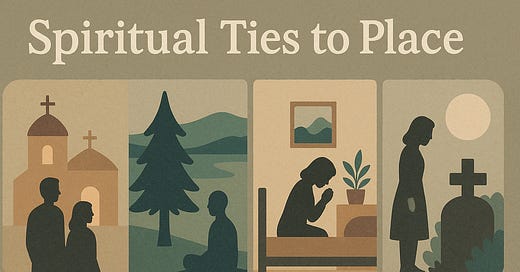“The earth is the Lord’s, and everything in it, the world, and all who live in it.”
— Psalm 24:1
“The place God calls you to is the place where your deep gladness and the world’s deep hunger meet.” – Frederick Buechner
On this Earth Day, we remember that our connection to place is not just environmental—it is spiritual. The ground beneath our feet is not just where we stand; it’s often where we meet God.
This is the heart of Spiritual Ties to Place (STP)—a person’s perceived connection to the sacred in or through a specific location.
In our newly published study in Psychology of Religion and Spirituality, we explored how people across three major faith traditions—Christianity, Islam, and Judaism—experience sacredness in the spaces around them. Using latent class analysis, we discovered four distinct spiritual place profiles:
Worship Spaces (STP-W)
Natural Environments (STP-N)
Private/Domestic Spaces (STP-P)
Unfrequented or Symbolic Places (STP-U)
Let’s unpack what the data say about these sacred connections—and what they mean for human flourishing.
How We Experience the Sacred
Each spiritual profile reflects a unique emotional and spiritual tone.
Worship Spaces (STP-W) are steeped in sociality, ritual, and religious praxis. These are spaces of collective identity. As one participant in our qualitative responses put it: “When I step into the mosque, it’s like my heart finally knows where it is.”
Natural Environments (STP-N) evoke peacefulness and transcendence. They whisper awe and stillness: “In the forest, I don’t need words to pray.”
Private Spaces (STP-P) carry the scent of safety and memory—they anchor us in personal ritual. Think bedside prayers, morning meditations, or candlelit journaling.
Unfrequented Places (STP-U), like cemeteries or ancestral lands, carry symbolic weight and spiritual depth. These are the quiet corners of the sacred. As someone described: “No one goes there anymore, but I still hear my grandmother’s voice.”
Spiritual ties to place aren’t just about where we go—they reveal how we process presence, belonging, memory, and transcendence.
Who Connects Where—And Why It Matters
When we break this down by person variables, the patterns get even more intriguing:
Men are more likely to report STP-W, while women show stronger ties to private and natural spaces (STP-P, STP-N).
Christians lean toward worship and private spaces, Muslims show a strong STP-W presence, and Jews show balanced ties across profiles—with slight favor toward private and symbolic places.
Rural individuals report stronger ties to all place types, especially natural and worship spaces.
Those with higher education levels show more engagement with natural and symbolic places, possibly reflecting broader spiritual exploration.
Younger adults (<26) gravitate toward private and unfrequented spaces, which might mirror their search for meaning outside traditional institutions.
Spiritual place isn't static—it's shaped by age, context, and culture. But what remains constant is the human longing to touch the sacred in physical space.Implications for Well-Being and Community Life
Why does this matter?
Mental Health: Sacred places offer emotional refuge. Knowing your STP profile could guide spiritual coping strategies during times of stress or loss.
Urban Design: If natural environments foster transcendence, how can cities create accessible sacred greenspaces
Faith Formation: Churches, mosques, synagogues—your space is more than a building. It’s a spiritual anchor for identity, memory, and hope.
Interfaith Relevance: Despite theological differences, the universal need for sacred place connects us all.
Final Reflection:
Some places whisper. Some sing. Others—like a grave, a garden, or a kitchen corner—simply listen as we meet God there.
So today, ask yourself:
Where do I feel closest to God?
What space holds my prayers, my silence, my soul?
Let Earth Day remind us:
🕊️ Creation isn’t just a backdrop.
It’s part of the story of faith.
It’s where dust becomes holy.
And where the sacred still meets us.
—
Funded by: Council for Christian Colleges & Universities (CCCU)
References:
Counted, V., Meagher, B., & Cowden, R. (2024). The nature of spiritual ties to place: A conceptual overview and research agenda. Ecopsychology, 16(1), 60-70. https://doi.org/10.1089/eco.2022.0078
Meagher, B. R., Cowden, R. G., Goldammer, L., Piazza, M., Aten, J., & Counted, V. (2025). The varieties of spiritual ties to place: A latent class analysis. Psychology of Religion and Spirituality. Advance online publication. https://doi.org/10.1037/rel0000560







